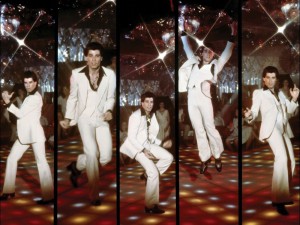
The origins of disco are actually local, stemming from the club-going counterculture in late ’60s and early ’70s Philadelphia and New York City. In many ways, the genre was an adaptation of classic soul with features of psychedelia as interpreted by the black, Latino and gay communities of these cities. The genre quickly evolved beyond its roots, as DJs developed the “remix” and started to define the disco sound every weekend in the clubs. The fundamental instrumentation — four-on-the-floor drum pattern, eighth-note open hi-hat, syncopated bass line and lavish orchestral or keyboard accompaniment — is iconic, and its influence and innovation can still be heard on the radio. Yet even before that sound crystallized, the genre was gaining commercial traction with songs such as “Soul Makossa” and “Kung Fu Fighting” in the early ’70s, and the television show “Soul Train” featured the disco sound. Still, the genre was underground music, only popular within an urban subculture. In order to achieve true popularity, an act more marketable needed to bridge the gap.
Enter the Bee Gees, a pop trio of brothers who rode a danceable disco style to commercial success in the mid ’70s. “Saturday Night Fever” producer Robert Stigwood, who needed a hit disco soundtrack for his movie to be a blockbuster, approached the Gibb brothers (Barry, Maurice and Robin) to write original material for his movie, which was already in post-production.
The Bee Gees agreed, and with only a vague idea of the movie’s concept, they quickly wrote four No. 1 hits, including “Stayin’ Alive,” “Night Fever,” “How Deep Is Your Love” and Yvonne Elliman’s “If I Can’t Have You.” The Bee Gees-led soundtrack skyrocketed to the top of the charts, spending 24 weeks at No. 1 in 1978. The album’s terrific track listing, as well as John Travolta dancing in his white jumpsuit, signaled the beginning of disco’s mainstream popularity. In a matter of months, disco went from a bubbling undercurrent to a major pop-culture phenomenon.
All the popularity aside, “Saturday Night Fever” is a brilliant move on the part of Stigwood. As he predicted, the movie introduced the extravagant and escapist disco sound and lifestyle to a much larger audience. It was a bold move for the artists involved, especially the Bee Gees. Defining a genre is no easy task, but the artists involved and included on the soundtrack provided a terrific gateway. The true achievement of the soundtrack is that it shows both disco’s star power and its compelling diversity.
There are disco versions of classical pieces (“A Fifth of Beethoven” and “Night on Disco Mountain”) that seamlessly integrate orchestral arrangements into the main framework. On the other hand, syncopated salsa rhythms and dramatic horn sections reverberate through tracks such as “Open Sesame” and “Salsation.” MFSB’s “K-Jee” even manages to combine these two disparate influences, creating something both lush and funky.
Thankfully, “classic” long-form four-on-the-floor disco closes the album with The Trammps’ blistering 11 minute “Disco Inferno.”
Of course, the work of the Bee Gees on this album cannot be ignored. While not pure disco, the strutting “Stayin’ Alive” and the slinky “Night Fever” brought fresh new fervor to an already innovative genre.
Though the Gibb brothers were never a part of the original community that defined disco, they inhabited its musical territory convincingly. The genre would fall out of favor by the end of the ’70s, but “Saturday Night Fever” is a timeless distillation of disco that ensures it will live forever.

